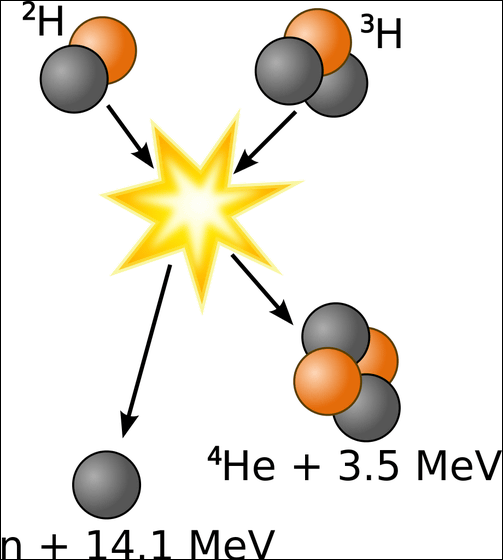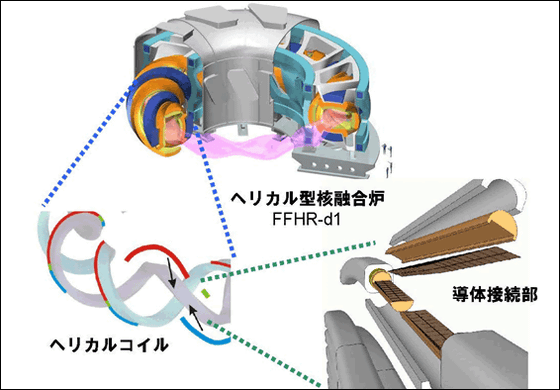A superconducting magnet under development by Japan achieves super-high current of 100,000 A, one step closer to the realization of a nuclear fusion reactor

ByPaulina Clemente
Lead the world's nuclear fusion reactor researchNuclear Fusion Science InstituteHas succeeded in fabricating a state-of-the-art high-temperature superconducting conductor, achieving an ultra-high current of 100,000 amperes, far exceeding the conventional recording. This collaboratively developed magnetic material of Tohoku University, which produces this unprecedented current, is a dream power plant "Fusion reactorIt is hoped to get closer to the realization of "
Press Release / Institute for Natural Sciences National Institute for Fusion Science
http://www.nifs.ac.jp/press/140331.html
It does not emit carbon dioxide unlike a thermal power plant and it is relatively safe because uncontrollable chain reaction like a nuclear power plant does not occur in principle and it is relatively safe enough to cover the energy of the whole earth in one cycle A "nuclear fusion reactor" capable of producing huge energy is expected to be commercialized as soon as possible as a technology capable of solving the energy problem of the 21st century.

BySteve Jurvetson
A nuclear fusion reactor expressed as "to create a small sun on the earth"Nuclear fusionIt is an energy creation device that utilizes the phenomenon phenomenon. Nuclear power plants emit energy as heavy elements divide into two or more lighter elementsFission reactionOn the other hand, in the fusion reactor, the mechanism differs by 180 degrees from the point of using nuclear fusion reaction which releases energy when relatively light elements such as hydrogen and helium fuse together and become heavier elements It is.
Nuclear fission is made of uranium or plutonium as a raw material, and fission products generated after the reaction are easy to undergo radioactivity and chain reaction, which is difficult to control and post treatment, whereas it is a general nuclear fusion reactionD-T reaction, Only helium is produced from deuterium and tritium, which are isotopes of hydrogen.Helium itself is a valuable gas for recyclingIn addition, due to the principle of the reaction, there is no danger of runaway because of the principle of reaction, safety is excellent and the superiority that the amount of generated energy is much larger than that of fission is given to the fusion reactor There is a strong desire for early implementation as a trump card to solve energy problems.

Although it is a nuclear fusion reactor with much bigger merit than conventional power plants, it is a major disadvantage that technical hurdles are extremely high for realization. In order to carry out nuclear fusion, it is necessary to separate electrons from the atoms of the element to be fused into nuclear states, so that the gas is ionizedplasmaThe state is used as a place of reaction. In other words, deuterium · tritium is caused to collide in plasma state to cause nuclear fusion reaction.
However, in order for nuclear nuclei to collide with each other and cause a nuclear fusion reaction, it is necessary to give enough energy to exceed the electrical repulsion (Coulomb force) between the nuclei. For that reason, in a fusion reactor it is necessary to set the plasma to a temperature higher than 100 degrees Celsius. However, it is extremely difficult to confine such ultra-high temperature plasma, which is one of the major hurdles to realizing a nuclear fusion reactor .

Therefore, what is considered to be a major technology to confine ultra high temperature plasma is "Tokamak typeIn the tokamak type, it is possible to hold the plasma in a torus shape (donut shape) by changing the magnetic field with three kinds of coils. However, although it is extremely difficult to design because it requires a far more complicated three-dimensional shape than a tokamak type, it is possible to generate a magnetic field that stably confines plasmas to a tokamak type or more than "Helical typeAs a helical type apparatus, "Fusion Science Institute's"LHD"Is technologically leading the world.

An important key in a nuclear fusion reactor based on a helical type plasma confinement system is an electromagnet that can adjust the magnetic field with electric current. However, the electromagnet used in the nuclear fusion reactor needs to stably flow a large current. In the case of a normal conductive magnet using copper, it is necessary to cool the electromagnet in order to suppress the temperature rise, and the electric power necessary for this cooling is fusion It is obvious that it is ineligible as a power plant because there is a risk of exceeding the final power generation amount of the furnace and instead it is necessary for a superconducting magnet that uses a superconductor whose electrical resistance becomes zero when the temperature falls below a certain temperature Sex is being cast.
In March 2014, the Nuclear Fusion Science Laboratory joined 54 "yttrium-based" high-temperature superconducting tape wires with a width of 10 mm and a thickness of 0.2 mm sandwiched between copper and stainless steel casings using low resistance connection technology Announced that it achieved ultra-high current value to rewrite the world record. In the fusion reactor, development of a stable and economical high temperature type superconductor is expected, but there were drawbacks in the complicated coil fabrication method that can be used for LHD. Corresponding to this, a conductor laminated with "Yttrium-based" high-temperature superconducting wire jointly developed with Tohoku University, with an absolute temperature of 20 degrees (Ce-minus 253 degrees) and an international thermonuclear fusion experiment reactor "ITER"We realized ultrahigh current far exceeding the performance of the conductor used in the"

Furthermore, the LHD boasted by the Institute of Fusion Science improves plasma performance by optimizing control of fuel particles such as hydrogen and helium, achieves 10 trillion units per 1 cc of density, achieves an ion temperature of 94 million degrees, We have also announced that it has succeeded in holding plasma for about 48 minutes with heating power of 1200 kW in operation. "To design nuclear fusion reactors that demonstrate power generation, we need to be able to see the plasma that burns in nuclear fusion at LHD, so that the ultimate goal of LHD 120 million degrees It is necessary to achieve ion temperature of 20 trillion per 1 cc of density and also to hold for 1 hour with heating power of 3000 kilowatts to demonstrate the steady operation of ultrahigh temperature plasma, but steadily advance toward that goal I was able to do it. "
Related Posts:
in Science, Posted by darkhorse_log







